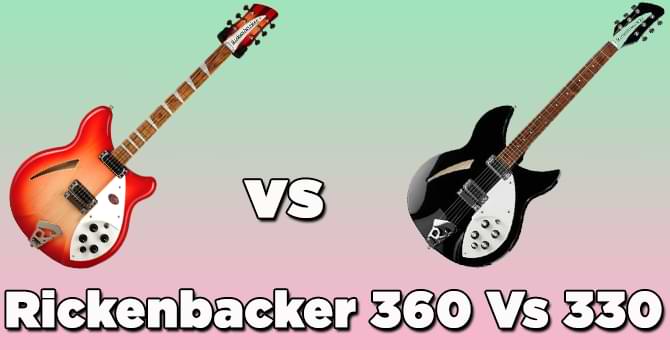Rickenbacker 360 Vs 330 [Difference & Which is Better]
In the realm of iconic electric guitars that have made an everlasting impact on music, Rickenbacker shines as a genuine symbol. Among their revered selections, the Rickenbacker 360 and 330 electric guitars stand out as cherished favorites among musicians for many years.

In this exploration, we will delve into the intricacies of the Rickenbacker 360 vs 330 models, meticulously dissecting their disparities across various facets. By the end of this journey, you’ll be equipped to unravel the eternal question: which of these masterpieces delivers the ultimate performance?
# Table of Contents =>
Comparison Table:
| Features – | Rickenbacker 360 | Rickenbacker 330 |
|---|---|---|
| Body Shape | Semi-Hollow | Semi-Hollow |
| Body Material | Maple | Maple |
| Top Material | Maple | Maple |
| Back Material | Maple | Maple |
| Neck Material | Maple | Maple |
| Fretboard | Rosewood | Rosewood |
| Fretboard Radius | 10″ | 10″ |
| Scale Length | 24.75″ | 24.75″ |
| Number of Frets | 24 | 24 |
| Pickups | Hi-gain Single-Coil x2 | Hi-gain Single-Coil x2 |
| Pickup Switching | 3-way toggle | 3-way toggle |
| Controls | Volume, Tone, Blend, 3-way switch | Volume, Tone, 2-way capacitor |
| Bridge | 6-Saddle Adjustable Bridge | 6-Saddle Adjustable Bridge |
| Tailpiece | “R” Tailpiece | Trapeze Tailpiece |
| Price Range | High | High |
| Notable Players | John Lennon, Peter Buck, Tom Petty | Tom Petty, John Fogerty |
Overview of Rickenbacker 360 –
The Rickenbacker 360 is an embodiment of elegance, innovation, and musical brilliance. The unique semi-hollow body design combines solid body attributes with the resonance of a hollow body, producing a tonal range that is both lush and harmonically intricate. The 360 showcases the iconic “R”-shaped sound-hole, a signature element of Rickenbacker’s design identity. The bound body exudes sophistication, while the double-cutaway design offers effortless access to the upper frets.
Semi-Hollow Elegance:
The Rickenbacker 360 boasts a semi-hollow body design, striking a balance between the tonal richness of a hollow body and the feedback resistance of a solid body.
Distinctive Soundhole:
Its signature “R”-shaped soundhole enhances resonance, contributing to a warm and harmonically complex tone.
Bound Body:
The bound body adds a touch of sophistication to the design, highlighting its classic aesthetics.
Double-Cutaway Design:
The double-cutaway design ensures easy access to higher frets, promoting fluid playability across the entire neck.
Versatility:
Equipped with “Hi-Gain” pickups and independent pickup switching, the 360 offers a versatile range of tones suitable for various genres.
Warm and Full Tones:
The semi-hollow construction delivers warm, full-bodied tones that shine equally in chord progressions and melodic solos.
Overview of Rickenbacker 330 –
Conversely, the Rickenbacker 330 embodies a completely hollow body structure, capturing the vintage tone and vibrant acoustics. Without a central block, the harmonic interplay between the strings and body is heightened, resulting in a distinctively “jangly” sound. While the 330 shares many design elements with its sibling 360, it forgoes the binding on the body, resulting in a more understated aesthetic.
Fully Hollow Vintage Vibe:
The Rickenbacker 330 features a fully hollow body construction, embracing vintage tonal qualities and resonant acoustics.
Jangle-Pop Delight:
Its absence of a center block gives rise to a bright, jangly sound that’s reminiscent of classic ’60s rock.
Understated Aesthetics:
The unbound body design exudes a simple elegance that harkens back to the golden era of rock ‘n’ roll.
24-Fret Neck:
With a 24-fret neck, the 330 offers extended range and versatility for players exploring higher registers.
Indie Rock Favorite:
Its chime-like, jangly tones make it a favorite among indie rock, jangle pop, and folk musicians.
Vintage Charm:
The 330 captures the raw and vibrant spirit of vintage rock music, transporting players back in time with every chord strummed.
Main Difference Between Both Rickenbacker 360 Vs 330:
a) Sound and Tone:
The sound and tone of an electric guitar play a pivotal role in defining its character and overall appeal. The Rickenbacker 360 and 330 exhibit subtle differences in this department. The Rickenbacker 360 tends to produce a slightly warmer and fuller tone due to its semi-hollow body construction.
This construction allows for more resonance and a broader tonal spectrum. On the other hand, the Rickenbacker 330, with its fully hollow body, produces a brighter and more resonant tone that leans towards a jangly and bell-like quality. The choice between the two depends on your preference for warmth and fullness or brightness and twang.
b) Design:

Both the Rickenbacker 360 and 330 share the same features in terms of design philosophy. Their subtle variations, however, set them apart. The 360, with its bound body, radiates an aura of refinement and luxury. Its semi-hollow construction is a harmonious blend of tonal integrity and ergonomic comfort.
Conversely, the 330’s fully hollow body exudes a vintage charm, harking back to the golden era of rock ‘n’ roll. Its unbound body channels a simpler aesthetic that focuses on the raw essentials.
c) Pickups:
Pickups are a critical factor in shaping an electric guitar’s sound. The Rickenbacker 360 and 330 models are both equipped with the brand’s proprietary “Hi-Gain” pickups, which are single-coil pickups known for their high output and distinct sound.
However, the 360 typically offers more tonal versatility due to its ability to switch between the neck and bridge pickups independently. This feature contributes to a wider range of sonic possibilities compared to the 330, which lacks this pickup configuration.
d) Neck, Fretboard, and Strings:

Both the Rickenbacker 360 and 330 models feature a 24-fret neck and a rosewood fretboard, contributing to their smooth playability. The neck profile tends to be thinner, making it comfortable for players with various hand sizes. The choice of strings can significantly impact playability and tone.
The models usually come strung with Rickenbacker’s signature “10-46” gauge strings, striking a balance between playability and tone richness.
e) Versatility and Music Genre:
The versatility of an electric guitar is crucial, especially for musicians who explore various genres. The Rickenbacker 360 and 330 excel in different areas. The 360’s ability to switch between pickups and its slightly warmer tone make it versatile across genres such as rock, blues, and alternative.
The 330’s brighter and jangly tone makes it a favorite among players in genres like indie rock, jangle pop, and folk.
f) Playability and Comfort:
When your fingers dance across the fretboard, the guitar’s playability becomes paramount. The Rickenbacker 360 and 330 excel in providing a seamless and enjoyable playing experience. Their 24-fret necks are designed with precision and finesse, catering to various playing styles.
The neck profile, although thinner, maintains a balance between comfort and speed, making extended practice sessions a pleasure. Additionally, the semi-hollow and fully hollow body designs contribute to reduced weight, ensuring hours of musical exploration without fatigue.
g) Price Point:
While the allure of these guitars is undeniable, it’s essential to consider the financial aspect. The Rickenbacker 360 usually occupies a slightly higher price bracket compared to the 330. This difference in pricing can be attributed to the intricate semi-hollow construction of the 360. As an investment, both models hold their value well over time, with Rickenbacker’s reputation for quality craftsmanship and timeless design.
h) Decoding the Sound:
At the heart of the Rickenbacker 360 and 330 lies their distinct tonal signatures. The 360’s semi-hollow body contributes to a warmer, fuller sound that’s equally adept at smooth chords and biting leads. Its ability to balance richness and clarity makes it a versatile companion across various genres, from blues to alternative rock.
In contrast, the 330’s fully hollow body infuses its sound with a sparkling jangle that’s reminiscent of the ’60s British Invasion. Its chime-like tones are perfect for genres like jangle pop and indie rock.
Which One Should You Choose?
The ultimate question remains: which of these exceptional guitars should grace your collection? The answer lies within your musical journey. If you’re drawn to versatility, the Rickenbacker 360’s semi-hollow body and pickup configuration provide a broader sonic canvas.
It accommodates various genres and playing styles with finesse. On the other hand, if you’re enamored by the vintage charm and unique jangle of the fully hollow body, the Rickenbacker 330 will resonate deeply with you.
Conclusion: The Rickenbacker 360 vs 330 electric guitars stand as timeless pillars of musical craftsmanship. As you embark on your quest to choose between them, remember that both instruments are embodiments of Rickenbacker’s commitment to excellence. The 360’s semi-hollow body offers versatility and warmth, while the 330’s fully hollow body evokes a vintage jangle that captures the essence of a bygone era.
The decision between these two marvels ultimately rests upon your musical inclinations, desired tones, and personal preferences. Whichever path you choose, rest assured that you’re embracing a piece of musical history that will continue to inspire and resonate for generations to come.
FAQs –
Q: Which famous musicians have used the Rickenbacker 360 and 330?
A: The Rickenbacker 360 and 330 have been favored by numerous prominent musicians. For instance, The Beatles’ John Lennon and George Harrison both played Rickenbacker 325 models, which are closely related to the 330 design. The Byrds’ Roger McGuinn is known for his use of a Rickenbacker 360/12, a 12-string version of the 360. Tom Petty and Peter Buck of R.E.M. are also notable users of Rickenbacker guitars.
Q: What are some notable features of the Rickenbacker 360 and 330?
A: Both models typically feature a maple body with a semi-hollow construction, a set neck design, a distinctive headstock shape, and a unique vibrato tailpiece system. They are also known for their “Ric-O-Sound” output that allows for separate output of the neck and bridge pickups.
Q: Are there any variations or special editions of these models?
A: Over the years, Rickenbacker has released various limited edition versions, signature models, and updated versions of the 360 and 330. These variations might feature different finishes, hardware options, and pickup configurations to cater to specific player preferences.
Last Updated on September 10, 2023 by Perry Garner


